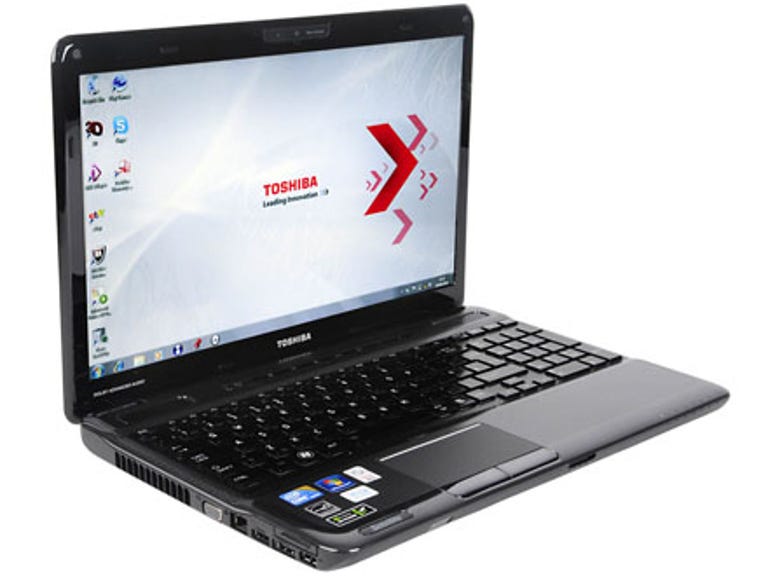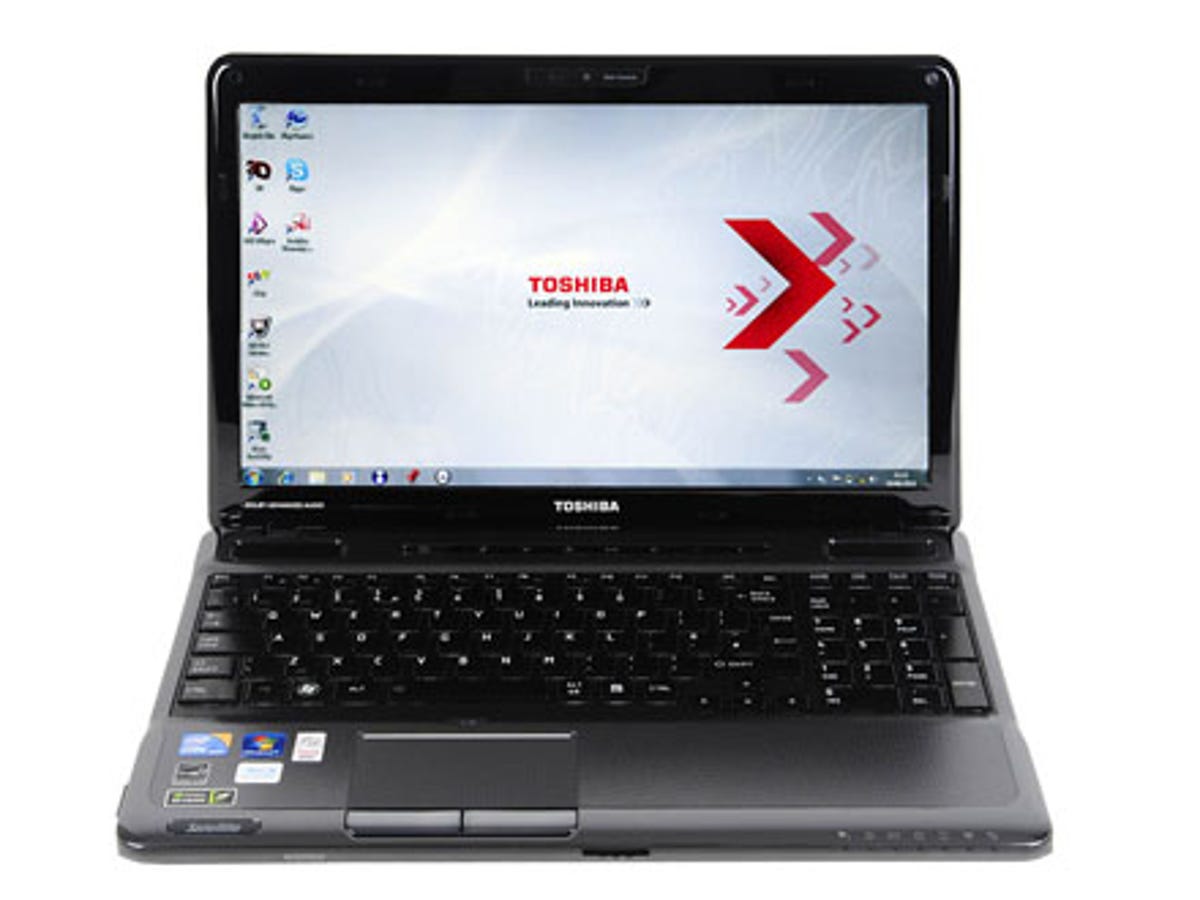 Why You Can Trust CNET
Why You Can Trust CNET Toshiba Satellite A665-11Z review: Toshiba Satellite A665
The Toshiba Satellite A665-11Z isn't the most powerful laptop in this price range, but it does pack 3D capability into an attractive, highly usable, 15.6-inch machine.
So you might have heard about this thing called 3D, that, we're reliably informed, is right on the cusp of becoming the greatest technological innovation ever to grace our miserable mortal lives. TV and movies are all well and good, but if you ask us, gaming is where the real value of 3D lies.
The Good
The Bad
The Bottom Line
Here, then, is the Toshiba Satellite A665, a 15.6-inch gaming laptop that ships with Nvidia's 3D vision kit to get you gaming in three glorious planes of existence. Our configuration, the A665-11Z, can be yours for £1,300 and is available from PC World.
Business up front
We usually expect high-spec gaming and multimedia machines to look pretty flashy -- a few glowing alien skulls here, the odd luminous speaker there -- but the A665 actually looks pretty normal. The lid has a matte black finish with an attractive chain pattern that creeps inside across the wrist rest.
The Satellite logo in the bottom left of the laptop is illuminated with white LEDs, as is a strip across the top of the trackpad, and the keyboard is backlit with the same gentle white luminescence. Far from being boring, we think the A665 looks rather classy.
Around the edges of this demure monster you'll find VGA and HDMI outputs, an eSATA/USB port, Ethernet port, media card reader, four USB ports, a Blu-ray rewritable drive and 3.5mm sockets for headphones and a mic -- essential if you're into multiplayer gaming. On the left side, the various ports are a bit cramped to make room for a truly massive fan exhaust, so if you're plugging in a couple of really bulky USB devices you might have to plan out your ports carefully.
This laptop is slim and light for a high-spec machine. It measures 397 by 254 by 35mm (at it's thickest point) and weighs 2.9kg, so it won't cause your spine to splinter if you try and lift it. In fact, it's comfortable to hold, so if you need to drag it around to your friend's house, it's quite manageable.
The trackpad is pleasantly large and very responsive. We found the keyboard comfortable to use and sensibly laid out -- even if the keys don't offer as much travel as other laptops.
The 15.6-inch display has a maximum resolution of 1,366x768 pixels, and this panel really is one of the A665's strongest assets. It's bold, bright and, while it isn't Full HD resolution, it's high enough to keep things looking really crisp. The best thing, though, is that this display has a maximum refresh rate of 120Hz (required to handle the 3D goodness). Whack this on and you'll be impressed at the smoothness with which your normal 2D computing moves -- it makes boring tasks like Web browsing and just skipping around the operating system feel a whole lot more luxurious.
Party in the back
Alright, let's check out the 3D magic. In the box, you'll find the Nvidia 3D vision kit, which comprises an Nvidia IR emitter, which plugs into the laptop via USB, and the 3D-vision glasses. The glasses communicate with the laptop via the IR emitter to deliver a stereoscopic image on the display. If you need to adjust the depth of the 3D effect, there's a dial on the back of the IR emitter that'll do just that.
Set-up is pretty simple. From the Nvidia control panel, you run a set-up wizard, which we found made things really straightforward. We encountered an error the first time around, and had to hunt for the option to set the refresh rate to the requisite 120Hz, but after that, things worked well.
Aside from being easy to set up, we were impressed by the effect itself. There's a real sense of depth disappearing into the screen, and although the glasses do make everything seem a lot darker, they didn't make things annoyingly dim, or introduce flicker. We've never been completely convinced of the widespread practicality of 3D, but if there's anywhere this doubt subsides, it's gaming. The hardcore crowd might prefer to keep things 2D when it comes to twitch responses and pixel-hunting headshots from miles away but, for an immersive experience, we found the 3D really helped us get our heads in the game.
Admittedly, the Nvidia kit does a better job with some games more than others. When we played Crysis, for example, we found many objects were out of perspective. To be fair, Nvidia do provide a reasonably thorough list of games that work well and those that don't. Games are rated from Excellent to Not Recommended, and the list includes tips and advice for smoothing out broken elements in the game's own graphics options.
The A665-11Z throws its weight around in terms of hardware. The whole system is powered by a quad-core Intel Core i7-740QM CPU, clocked at 1.73GHz, and with a maximum speed of 2.93GHz with TurboBoost enabled. Backed up by 4GB of DDR3 RAM and an Nvidia GeForce GTS 350M graphics card, we found the A665-11Z scored a respectable 6,357 when we ran our PCMark05 benchmark tests.
We've seen higher scores in other high-spec machines (the identically priced HP Envy 17 recently scored 7,201, while the monstrous Alienware M17x scored an astronomical 11,399), but with a score like that, you won't experience any slowdown in regular or multimedia use.
Graphically, things are more impressive. In our 3DMark06 benchmark test, the A665-11Z scored 8,338 at a resolution of 1,280x768, and 8,196 at the maximum supported resolution of 1,366x768. Turning on the 3D did drag those scores down -- with the test running at default and maximum native resolutions, the machine scored 5,039 and 4,892 respectively. Although, again, not the best we've ever seen, these scores should make the A665 capable of handling most current-generation games.
Battery life is pretty rubbish on the A665-11Z. We know this isn't exactly a super-portable machine, but still, only 51 minutes and 43 seconds of battery life (according to our Battery Eater Classic test) with the CPU at a constant 100% isn't very impressive. Storage, on the other hand, isn't so paltry thanks to a 500GB hard drive. The A665-11Z is running on 64-bit Windows 7 Home Premium.
Conclusion
In terms of pure performance, we've seen better multimedia and gaming machines. What we haven't seen -- until now -- is one that packs 3D right out of the box into an attractive chassis with a winning display and high usability. It's expensive, but all things considered, we think the Toshiba Satellite A665-11Z is a thoroughly decent laptop.
If you're not fussed about the 3D and want more computing grunt for the same money, consider the Toshiba Qosmio X500-128.
Edited by Emma Bayly



